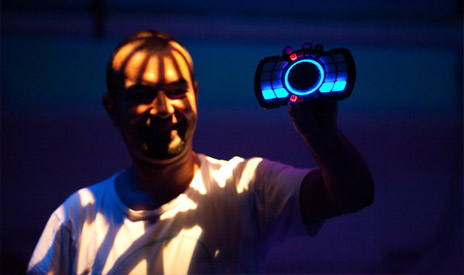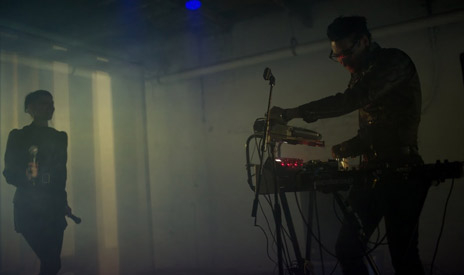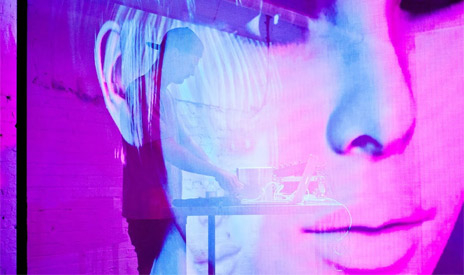- For anyone with an ear to the ground in the US electronic scene, there's a buzz around Pittsburgh's VIA, which is said to be haven for underground electronic music in a town with almost zero precedent for it. Sure, the economically depressed Rust Belt city has been making waves with Pittsburgh Track Authority and parties like Humanaut, but it's not renowned for its dance scene. Now in its fourth year, VIA, which is run by just two people and an army of volunteers, was forced to scale things back, meaning the 2013 edition didn't have quite the blockbuster lineups of past years, though it was still adventurously curated. In just one night, VIA could easily move between the scream therapy noise of Pharmakon, the straight-up house and disco of Hunee and the grizzled techno of Container.
The most surprising thing about VIA (at least from a first-timers' perspective) is the size. It's not big. The location for the first two nights was Brillobox, a pub that couldn't have held more than 100 people. Intimacy certainly isn't a bad thing, but the venue seemed remarkably tiny for what, on paper, looks like a world-class festival. That said, when the venues got bigger, the audience couldn't quite match up. Thursday night's dance party at The Rex Theatre was about half empty by the time Jimmy Edgar finished his high-energy set. Being followed by Actress didn't help. The UK experimentalist brought things down to a low-boil with lots of strange transitions and extended ambient passages, crouching behind the table and giving the whole thing a faceless feel that wasn't right for the peak-time slot.
 Photo credit: Laila Archuleta
On Friday and Saturday, proceedings moved to a former community centre in Pittsburgh's slowly redeveloping East End. The two-room parties had main acts playing in the loading bay, while a smaller area was dedicated to film screenings, local artists and games. It was a clever use of space, but even this one only held a few hundred people. Both parties struggled to stay full through to their 4 AM closing times, though it was no fault of the music. Jacques Greene played straightforward house between choppier sets by Lapalux and Total Freedom, who seemed to have trouble keeping command of the fickle crowd. KiNK and Hunee had the same problem on Saturday, but Vessel and synth-pop act ADULT. had partygoers in the palm of their hands, suggesting a preference for moodier fare over the straight up dance music.
Photo credit: Laila Archuleta
On Friday and Saturday, proceedings moved to a former community centre in Pittsburgh's slowly redeveloping East End. The two-room parties had main acts playing in the loading bay, while a smaller area was dedicated to film screenings, local artists and games. It was a clever use of space, but even this one only held a few hundred people. Both parties struggled to stay full through to their 4 AM closing times, though it was no fault of the music. Jacques Greene played straightforward house between choppier sets by Lapalux and Total Freedom, who seemed to have trouble keeping command of the fickle crowd. KiNK and Hunee had the same problem on Saturday, but Vessel and synth-pop act ADULT. had partygoers in the palm of their hands, suggesting a preference for moodier fare over the straight up dance music.
 Photo credit: Arvin Clay
The most memorable thing about those two nights wasn't even the music—it was the cage of screens that enveloped the artists. Projections on the back wall were augmented by three transparent screens on each side of the performer. This 3D video fence provided some trippy moments, most notably the belt of falling detritus during Vessel's set. VIA was impressively dedicated to visuals in general, with each concept helmed by a different artist. There were black-and-white projections strobing behind FORMA's incredible performance at Brillobox, and the Rex Theatre was adorned with giant lit-up Tetris blocks that flashed and changed colours with the music.
Photo credit: Arvin Clay
The most memorable thing about those two nights wasn't even the music—it was the cage of screens that enveloped the artists. Projections on the back wall were augmented by three transparent screens on each side of the performer. This 3D video fence provided some trippy moments, most notably the belt of falling detritus during Vessel's set. VIA was impressively dedicated to visuals in general, with each concept helmed by a different artist. There were black-and-white projections strobing behind FORMA's incredible performance at Brillobox, and the Rex Theatre was adorned with giant lit-up Tetris blocks that flashed and changed colours with the music.
 Photo credit: Laila Archuleta
Location is crucial for multi-venue festivals like VIA, and at times Pittsburgh felt like a bit of a strange one. Large swathes of the city seemed empty, and the venues were spread throughout different neighbourhoods. Coupled with the small turnout, this could make the festival feel lacking in energy. On top of that, late night transport is basically impossible, thanks to a bus service that stops early and a puzzling lack of cabs, so if you didn't have a ride or couldn't walk, you'd have a frustrating time getting home. Nonetheless, VIA was often remarkably spirited, and night after night, as the crowds were reduced to their core constituents, a communal feeling stared to emerge.
VIA's final day took place at Bayardstown Social Club, a venue that felt uniquely Pittsburgh. Humbly decorated and set in an empty industrial area, it had the feeling of a backyard party, complete with dogs running around. There weren't very many people there; by the time Slava came on around 8:30 PM most of the audience was sitting down, with maybe 15 people paying any attention to the music. But nearly everyone was familiar from the other nights of the festival, all friendly, happy and excited. Even if VIA has lots of room to grow, they've got a passionate base to build on—and if they can pull of a festival of this calibre in that kind of setting, who knows what they'll be capable of in a few years.
Photo credit: Laila Archuleta
Location is crucial for multi-venue festivals like VIA, and at times Pittsburgh felt like a bit of a strange one. Large swathes of the city seemed empty, and the venues were spread throughout different neighbourhoods. Coupled with the small turnout, this could make the festival feel lacking in energy. On top of that, late night transport is basically impossible, thanks to a bus service that stops early and a puzzling lack of cabs, so if you didn't have a ride or couldn't walk, you'd have a frustrating time getting home. Nonetheless, VIA was often remarkably spirited, and night after night, as the crowds were reduced to their core constituents, a communal feeling stared to emerge.
VIA's final day took place at Bayardstown Social Club, a venue that felt uniquely Pittsburgh. Humbly decorated and set in an empty industrial area, it had the feeling of a backyard party, complete with dogs running around. There weren't very many people there; by the time Slava came on around 8:30 PM most of the audience was sitting down, with maybe 15 people paying any attention to the music. But nearly everyone was familiar from the other nights of the festival, all friendly, happy and excited. Even if VIA has lots of room to grow, they've got a passionate base to build on—and if they can pull of a festival of this calibre in that kind of setting, who knows what they'll be capable of in a few years.
 Photo credit: Laila Archuleta
On Friday and Saturday, proceedings moved to a former community centre in Pittsburgh's slowly redeveloping East End. The two-room parties had main acts playing in the loading bay, while a smaller area was dedicated to film screenings, local artists and games. It was a clever use of space, but even this one only held a few hundred people. Both parties struggled to stay full through to their 4 AM closing times, though it was no fault of the music. Jacques Greene played straightforward house between choppier sets by Lapalux and Total Freedom, who seemed to have trouble keeping command of the fickle crowd. KiNK and Hunee had the same problem on Saturday, but Vessel and synth-pop act ADULT. had partygoers in the palm of their hands, suggesting a preference for moodier fare over the straight up dance music.
Photo credit: Laila Archuleta
On Friday and Saturday, proceedings moved to a former community centre in Pittsburgh's slowly redeveloping East End. The two-room parties had main acts playing in the loading bay, while a smaller area was dedicated to film screenings, local artists and games. It was a clever use of space, but even this one only held a few hundred people. Both parties struggled to stay full through to their 4 AM closing times, though it was no fault of the music. Jacques Greene played straightforward house between choppier sets by Lapalux and Total Freedom, who seemed to have trouble keeping command of the fickle crowd. KiNK and Hunee had the same problem on Saturday, but Vessel and synth-pop act ADULT. had partygoers in the palm of their hands, suggesting a preference for moodier fare over the straight up dance music.
 Photo credit: Arvin Clay
The most memorable thing about those two nights wasn't even the music—it was the cage of screens that enveloped the artists. Projections on the back wall were augmented by three transparent screens on each side of the performer. This 3D video fence provided some trippy moments, most notably the belt of falling detritus during Vessel's set. VIA was impressively dedicated to visuals in general, with each concept helmed by a different artist. There were black-and-white projections strobing behind FORMA's incredible performance at Brillobox, and the Rex Theatre was adorned with giant lit-up Tetris blocks that flashed and changed colours with the music.
Photo credit: Arvin Clay
The most memorable thing about those two nights wasn't even the music—it was the cage of screens that enveloped the artists. Projections on the back wall were augmented by three transparent screens on each side of the performer. This 3D video fence provided some trippy moments, most notably the belt of falling detritus during Vessel's set. VIA was impressively dedicated to visuals in general, with each concept helmed by a different artist. There were black-and-white projections strobing behind FORMA's incredible performance at Brillobox, and the Rex Theatre was adorned with giant lit-up Tetris blocks that flashed and changed colours with the music.
 Photo credit: Laila Archuleta
Location is crucial for multi-venue festivals like VIA, and at times Pittsburgh felt like a bit of a strange one. Large swathes of the city seemed empty, and the venues were spread throughout different neighbourhoods. Coupled with the small turnout, this could make the festival feel lacking in energy. On top of that, late night transport is basically impossible, thanks to a bus service that stops early and a puzzling lack of cabs, so if you didn't have a ride or couldn't walk, you'd have a frustrating time getting home. Nonetheless, VIA was often remarkably spirited, and night after night, as the crowds were reduced to their core constituents, a communal feeling stared to emerge.
VIA's final day took place at Bayardstown Social Club, a venue that felt uniquely Pittsburgh. Humbly decorated and set in an empty industrial area, it had the feeling of a backyard party, complete with dogs running around. There weren't very many people there; by the time Slava came on around 8:30 PM most of the audience was sitting down, with maybe 15 people paying any attention to the music. But nearly everyone was familiar from the other nights of the festival, all friendly, happy and excited. Even if VIA has lots of room to grow, they've got a passionate base to build on—and if they can pull of a festival of this calibre in that kind of setting, who knows what they'll be capable of in a few years.
Photo credit: Laila Archuleta
Location is crucial for multi-venue festivals like VIA, and at times Pittsburgh felt like a bit of a strange one. Large swathes of the city seemed empty, and the venues were spread throughout different neighbourhoods. Coupled with the small turnout, this could make the festival feel lacking in energy. On top of that, late night transport is basically impossible, thanks to a bus service that stops early and a puzzling lack of cabs, so if you didn't have a ride or couldn't walk, you'd have a frustrating time getting home. Nonetheless, VIA was often remarkably spirited, and night after night, as the crowds were reduced to their core constituents, a communal feeling stared to emerge.
VIA's final day took place at Bayardstown Social Club, a venue that felt uniquely Pittsburgh. Humbly decorated and set in an empty industrial area, it had the feeling of a backyard party, complete with dogs running around. There weren't very many people there; by the time Slava came on around 8:30 PM most of the audience was sitting down, with maybe 15 people paying any attention to the music. But nearly everyone was familiar from the other nights of the festival, all friendly, happy and excited. Even if VIA has lots of room to grow, they've got a passionate base to build on—and if they can pull of a festival of this calibre in that kind of setting, who knows what they'll be capable of in a few years.